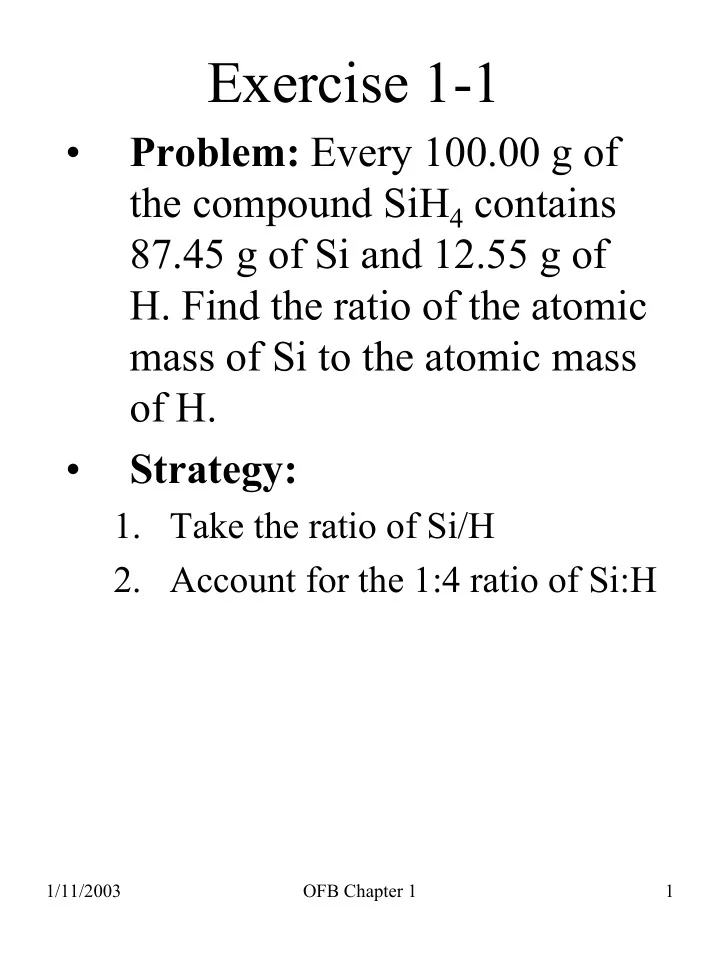

Exercise 1-1 • Problem: Every 100.00 g of the compound SiH 4 contains 87.45 g of Si and 12.55 g of H. Find the ratio of the atomic mass of Si to the atomic mass of H. • Strategy: 1. Take the ratio of Si/H 2. Account for the 1:4 ratio of Si:H 1/11/2003 OFB Chapter 1 1
Exercise 1-1 • Problem: Every 100.00 g of the compound SiH 4 contains 87.45 g of Si and 12.55 g of H. Find the ratio of the atomic mass of Si to the atomic mass of H • Solution: 87 . 45 g mass of 1 atom of Si = 12 . 55 g 4 X mass of 1 atom of H 87 . 45 g mass of 1 atom of Si ( ) = 4 X 12 . 55 g mass of 1 atom of H mass of 1 atom of Si = 27 . 87 mass of 1 atom of H 1/11/2003 OFB Chapter 1 2
Atoms • Avogadro’s Number is the number of 12 C atoms in exactly 12 grams of carbon • N 0 = 6.0221420 X 10 23 • The mass, in grams, of Avogadro's number of atoms of an element is numerically equal to the relative atomic mass of that element (relative to carbon) m = atom C 12g 1 atom C X 23 6.0221420 x 10 atom C − 23 = 1.9926465x 10 g 1/11/2003 OFB Chapter 1 3
Exercise 1-8 • Tetrodotoxin has the empirical formula C 11 H 17 N 3 O 8. Calculate the mass percentages of the four element in this compound. Solution: 1. Calculate molar mass of C 11 H 17 N 3 O, by finding the mass contributed by each element = + + + M (11 * 12.011) (17 * 1.0079) (3 * 14.007) (8 * 15.999) = M 319.1588 2. Divide the mass for each element by the total mass of the compound. 132.011 = = %C x100% 41.38%C 319.158 17.134 = = %H x100% 5 . 37 %H 319.158 42.021 = = %N x100% 13.16%N 319.158 127.992 = = 1/11/2003 OFB Chapter 1 4 %O x100% 40.09%O 319.158
1 mmol = 1 millimole =1x10 -3 mol 1mg = 1 milligram =1x10 -3 g 1/11/2003 OFB Chapter 1 5
Exercise 1-9 • Heating a 150.0mg dose of a compound used to treat rheumatism decomposes it to its constituent elements, which are separated. There are 60.29 mg of gold, 21.10 mg of sodium, 29.37 mg of oxygen, and 39.24 mg of sulfur. Determine the empirical formula of this compound. Solution : 1. Calculate the chemical amount (in moles) of each element in the sample using the table of atomic masses. 1mmol Au = = n 60.29mg Au x 0.306 mmol Au Au 196.97mg Au 1mmol Na = = n 21.10mg Na x 0.910 mmol Na Na 22.990mg Na 1mmol O = = n 29.37mg O x 0.1836 mmol O O 15.999mg O 1mmol S = = n 3 9 . 24 mg S x 1.223 mmol S S 32.065mg Au 2. Find the ratios of the moles for each element by dividing each by the smallest one, i.e., normalize to the smallest. 3. If necessary, multiply smallest factor that clears any fractions that they contain. 1/11/2003 OFB Chapter 1 6
Exercise 1-9 Determine the empirical formula of this compound. Solution : 1. Calculate the chemical amount (in moles) of each element in the sample using the table of atomic masses. 1mmol Au = = n 60.29mg Au x 0.306 mmol Au Au 196.97mg Au 1mmol Na = = n 21.10mg Na x 0.910 mmol Na Na 22.990mg Na 1mmol O = = n 29.37mg O x 0.1836 mmol O O 15.999mg O 1mmol S = = n 3 9 . 24 mg S x 1.223 mmol S S 32.065mg Au 2. Find the ratios of the moles for each element by dividing each by the smallest one, i.e., normalize to the smallest. n 0 . 306 1 mol Au Au = = = 1 n 0 . 306 1 mol Au Au n 0 . 910 2 . 97 mol N a Na = = = 3 n 0 . 306 1 mol Au Au n 1 . 836 6 . 0 mol O O = = = 6 n 0 . 306 1 mol Au Au n 1 . 223 4 . 0 mol S S = = = 4 n 0 . 306 1 mol Au Au ∴ AuNa O S 3 6 4 3. If necessary, multiply smallest factor that clears any fractions that they contain. 1/11/2003 OFB Chapter 1 7
Recommend
More recommend